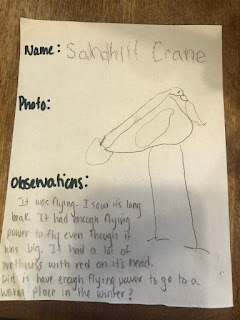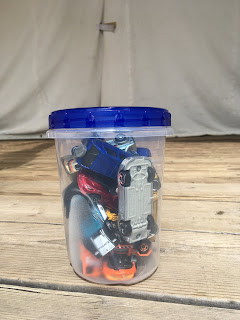Have you ever seen a bird carrying a stick or a branch? What do you think they're doing?
You guessed it, the bird is using that material to make their nests! Some birds make new nests each year, and others come back to the same one year after year. They make nests so that they can lay eggs there.
Tree branches, holes in tree trunks, holes in cliffs, bird houses, wooden platforms, other birds' nests--all of these are places where birds might make homes to lay their eggs. Did you know that birds don't always live in houses?
Watch Kaela read Birdhouse for Rent by Harriet Ziefert, and then check out some of the photos of Roots students with bird houses in Ponderosa State Park.
This past winter, many students from different classes walked over the snowy sagebrush meadow and noticed birdhouses!
When Tyran looked into this bird box, he saw this:
A nest was still in there from last year!
Tamaracks observing the birdhouse.
Avery holds up the door for his Pines friends to look inside.
In another box, students saw this:
That's not right! A bird box is meant to be a nesting spot for birds, not wasps!
In the spring, Roots students often help clean out the boxes with our friend Kerri Stebbins, who is a Master Naturalist volunteer.
Supplies that she brings:
1. Gloves;
2. Eco-friendly cleaner;
3. Big bristle brush;
4. Small bristle brush;
5. Vaseline (for rubbing in the inside corners of the boxes to keep wasps from building their nests there).
6. A small rag (optional) for wiping excess gunk off the boxes or patting them dry in between spraying the cleaner/using the brushes and applying the vaseline.
We put on plastic gloves to protect ourselves as well as the birds. Then, we used brushes to clean out any old items.
One box had materials from a previous nest! What all do you see in this nest?
Sometimes, there are nesting materials from an old nest. When we can tell that it's an old nest, we take it out so the birds can make a new nest in there. When I asked Kerri, she said "typically any nests left behind are last season's (and often there are leftover eggshells and/or dead wasps in the nests)" so she knows they're old.
Students worked together to put the nest back in the bird house and then close it up.
Now the boxes were ready for their next nesters!
You might be wondering about the bird boxes this year - will they be cleaned out?!
Yes! Our friend Kerri volunteers each year to clean out the bird boxes and she was able to go out this spring to get them ready.
Your friends,
Kaela and Genny



















































